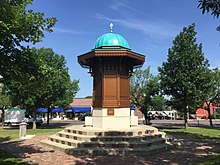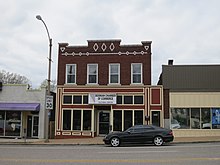| Part of a series on |
| Ethnic groups in St. Louis |
|---|


The city of St. Louis, Missouri, and metropolitan area is tied with Chicago, Illinois for the largest Bosnian American population in the United States, and has the largest Bosnian population outside of Bosnia. The highest concentration of Bosnians in St. Louis is in the "Little Bosnia" neighborhood of Bevo Mill. The Bosnian cultural imprint can be seen in the numerous Bosnian restaurants, bakeries, and cafes, as well as several Bosnian mosques and religious organizations.
History

The first wave of Bosnians arrived in the 1990s, refugees of the Bosnian War. [1] According to the refugee organization International Institute of St. Louis, the metropolitan area had about 70,000 people of Bosnian origins circa the late 1990s and early 2000s, the highest recorded number as of date. [2]
On September 29, 2013, the Bosnian community donated a replica of Sebilj (kiosk-shaped public fountain) to the city of St. Louis for its 250th birthday. [3] It was modeled after the famous 18th century one in Sarajevo, to mark the center of their community.
In 2014, a Bosniak-American named Zemir Begic was beaten to death with hammers. The murder caused shock in the Bosnian community of St. Louis and protests were held against violent crime. Because Begic was white and his suspected assailants were black and Latino, some claimed that the murder of Begic was an example of "black-on-white" crime while others claimed it was a "a targeted attack on Bosnians". While the belief that Begic was targeted due to his ethnicity or race contributed to racial tensions between the Black community and white Muslims of Bosnian descent, St. Louis police did not believe the attack had any ethnic or racial basis. [4] [5]
Demographics
As of 2013 there were 70,000 Bosnians in St. Louis. This was the largest population of Bosnians in the United States and the largest Bosnian population outside of Europe. Most are Bosniak and practice Islam, but a minority composed of Bosnian Serbs and Bosnian Croats practice other religions including Roman Catholicism and Eastern Orthodoxy.
As of 2013 [update] the highest concentrations of Bosnians are in the neighborhood of Bevo Mill. [6]
According to the 2022 5 Year American Community Survey, there were 7,686 foreign-born residents in the St. Louis Metropolitan region that were born in Bosnia and Herzegovina. However, there were 10,588 foreign-born residents in Chicago that were born in Bosnia and Herzegovina. [7]
| Place | Chicago MSA | Margin of Error | St. Louis MSA | Margin of Error |
|---|---|---|---|---|
| Bosnia and Herzegovina | 10,588 | ±1,260 | 7,686 | ±797 |
. [8] These numbers raise questions about the official count used in popular magazines.
See also
References
- ^ "Keeping Up With the Jasarevics". The Riverfront Times. Retrieved 2013-01-31.
- ^ Delkic, Melina (2019-08-18). "'It's Not the Same': Why War Refugees Who Helped Revive St. Louis Are Leaving". The New York Times. Retrieved 2021-12-14.
- ^ In Little Bosnia, a gift from immigrants -
- ^ "Are the media ignoring another St Louis killing?". BBC. Retrieved 2022-04-17.
- ^ "St. Louis Bosnians Have Been Dragged to the Forefront of the City's Racial Tensions". Vice News. Retrieved 2022-04-17.
- ^ Gilsinan, Kathy. "Why Are There So Many Bosnians in St. Louis?". The Atlantic Cities. Atlantic Media Company. Retrieved 15 February 2013.
- ^ https://www.census.gov/
- ^ https://data.census.gov/table/ACSDT5Y2022.B05006?q=B05006:%20Place%20of%20Birth%20for%20the%20Foreign-Born%20Population%20in%20the%20United%20States&g=310XX00US16980,41180
Further reading
- Moore, Doug. " Bosnians in St. Louis area mark a time of trouble " ( Archive). St. Louis Post-Dispatch. April 6, 2012.
- Sanchez, Margaux Wexberg. " Bosnians in St. Louis: Reflection 20 years after start of war." St. Louis Beacon. Friday April 6, 2012.
- Schuessler, Ryan. " Yugoslavia’s children, grown up in St. Louis" ( Archive). Al Jazeera America. February 22, 2012.
- McCarthy, Patrick., Cogo, Akif. " Bosnian St. Louis: Between Two Worlds". Missouri Historical Society Press. November 1, 2022.